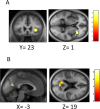Neural correlates of early cognitive dysfunction in Parkinson's disease
- PMID: 31139688
- PMCID: PMC6529983
- DOI: 10.1002/acn3.767
Neural correlates of early cognitive dysfunction in Parkinson's disease
Abstract
Objective: Dementia is a common and feared aspect of Parkinson's disease but there are no robust predictors of cognitive outcome. Visuoperceptual deficits are linked to risk of dementia in Parkinson's disease but whether they predict cognitive change is not known, and the neural substrates of visuoperceptual dysfunction in Parkinson's have not yet been identified.
Methods: We compared patients with Parkinson's disease and unaffected controls who underwent BOLD fMRI while performing our previously validated visuoperceptual task and tested how functional connectivity between task-specific regions and the rest of the brain differed between patients who performed well and poorly in the task.
Results: We show that task performance at baseline predicts change in cognition in Parkinson's disease after 1 year. Our task-based fMRI study showed that the performance in this task is associated with activity in the posterior cingulate cortex/precuneus. We found that functional connectivity between this region and dorsomedial prefrontal cortex was reduced in poor performers compared with good performers of this task.
Interpretation: Our findings suggest that functional connectivity is reduced between posterior and anterior hubs of the default mode network in Parkinson's patients who are likely to progress to worsening cognitive dysfunction. Our work implicates posterior default mode nodes and their connections as key brain regions in early stages of dementia in Parkinson's disease.
Conflict of interest statement
HRM reports personal fees from Teva, AbbVie, Boehringer Ingelheim, and GSK; RSW reports personal fees from GE.
Figures





References
-
- Williams‐Gray CH, Mason SL, Evans JR, et al. The CamPaIGN study of Parkinson's disease: 10‐year outlook in an incident population‐based cohort. J Neurol Neurosurg Psychiatry 2013;84:1258–1264. - PubMed
-
- Mak E, Zhou J, Tan LC, et al. Cognitive deficits in mild Parkinson's disease are associated with distinct areas of grey matter atrophy. J Neurol Neurosurg Psychiatry 2014;85:576–580. - PubMed
-
- Melzer TR, Watts R, MacAskill MR, et al. Grey matter atrophy in cognitively impaired Parkinson's disease. J Neurol Neurosurg Psychiatry 2012;83:188–194. - PubMed
-
- Song SK, Lee JE, Park HJ, et al. The pattern of cortical atrophy in patients with Parkinson's disease according to cognitive status. Mov Disord 2011;26:289–296. - PubMed
-
- Kurowska Z, Kordower JH, Stoessl AJ, et al. Is axonal degeneration a key early event in Parkinson's disease? J Parkinsons Dis 2016;6:703–707. - PubMed
MeSH terms
Grants and funding
LinkOut - more resources
Full Text Sources
Medical

